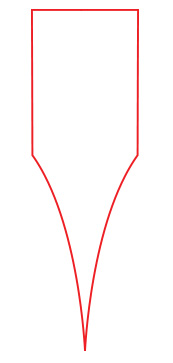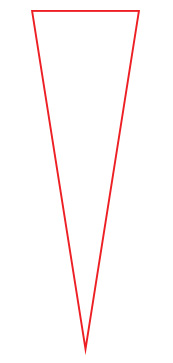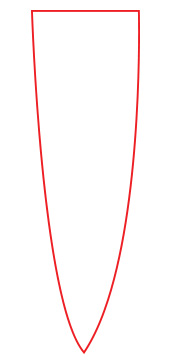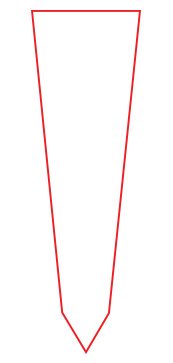Cutting through the confusion: A breakdown of common knife terminology.
Knives are one of those things you don’t realize how much you’ll use until it’s right there with you in your pocket. Whether you’re opening packages, doing quick fixes around the house, or enjoying the great outdoors, a good, sharp knife makes things easier and safer.
However, even if you’ve never thought about it consciously, you’ve certainly seen that knives come in a seeming countless number of shapes. Each one is designed with a specific purpose in mind and, just like the grind of a knife, each has its own unique set of pros and cons.
The Parts of a Knife
1. Spine
The blade back, usually unsharpened. Thick spines add strength.
2. Ricasso
The part of the blade between the handle and the beginning of the sharpened edge. Often features a “tang stamp,” the maker’s symbol.
3. Jimping
Grooves in the blade spine or handle for increased grip.
4. Belly
The curved part of the blade as the sharpened edge nears the tip.
5. Serrations
Many small points that scrape away a surface like a saw.
6. Choil
The unsharpened section of blade between the handle and sharpened edge.
7. Handle
8. Tang
The portion of the knife blade that extends below the handle.
Types of Knife Grind
The shape of the blade when viewed as a cross-section. The four most basic being:

Hollow Grind
A hollow grind is a style of knife grind that, when examined cross-sectionally, has a concave shape. This grind is produced by removing steel from the blade’s edge, resulting in a thin, sharp edge. Because of this, the hollow grind has a reputation for producing extremely sharp edges, making it popular among those who hunt and practice survival skills. However, the edge is thinner and has less steel support, which makes it more vulnerable to damage and necessitates more frequent upkeep and sharpening. Knives with a hollow grind are commonly used for tasks like slicing and skinning.

Flat Grind / V-Edge
The simplest type of edge is the flat grind, commonly referred to as a V-edge. It has an equal taper from the spine to the cutting edge, so the blade’s breadth is constant from the spine to the edge. A symmetrical edge is produced by this grind by reducing steel from both sides of the blade. This sort of grind is perfect for knives used for chopping and slicing jobs since it is simple to maintain and sharpen. The chef’s knife, which is the primary knife used in kitchens for slicing and chopping food, is a typical example of a knife with a flat grind.

Convex Grind
Due to the difficulties in sharpening, the convex grind, also known as a “axe grind,” is regarded as a highly specialized grind. By eliminating steel from the blade’s edge, this grind produces a convex shape as opposed to a concave form. This creates an edge that is thicker, stronger, and more resilient to wear and tear. The broader edge makes it harder to maintain and sharpen, though. Convex-ground knives are often used for labor-intensive jobs like chopping wood.

Compound Bevel
The compound bevel is the most frequent type of factory-made blades. It has a flat-grind-like constant taper, and the cutting edge is produced by a secondary bevel. In order to achieve this grind, steel is removed from both sides of the blade, resulting in a symmetrical edge. A secondary bevel is then introduced to the edge to produce a sharper edge. This gives the blade a sharp edge for cutting jobs and boosts the blade’s longevity due to the relative thickness of the rest of the blade. A good general-purpose grind that works well for many different jobs.
Knife Shape Types
The shape of the blade can determine strength, sharpness, piercing ability and ultimately which task it is best suited for.
Clip Point

The classic multi-purpose blade features a concave “clip” on the spine to increase the sharpness of the point. Useful for piercing, cutting in tight places, or as a pick. It is a common blade shape found on traditional pocket knives as well as larger hunting knives thanks to its versatility in different skinning applications as well as camp chores.

The sheepsfoot blade features a curved back and a flat straight edge. The dull back is made to be held with fingers for precision control, and was originally used to clip sheep’s hooves and frequently employed in whittling.
Drop Point

The drop point is one of the most common blades. Drop points also make good hunting knives: To avoid the tip from cutting into an animal’s organs while performing a field dressing, the drop point has a downward convex curve that lowers the point. The drop point design also offers a superb combo of strength and control, making it a smart choice for both demanding and delicate cutting jobs. They are also common in a wide variety of knives, including fixed blade, folding, and even kitchen knives.
Skinner

A narrow tip and wide, sweeping curved belly, a skinner is perfect for separating a hide from the meat and cutting through thick layers. Like the drop point, the downward facing point reduces the risk of cutting through the hide, while the more dramatic sweep up of the blade allows for longer and quicker horizontal slices while skinning.
Wharncliffe

The Wharncliffe blade is renowned for its distinctive design and durability. The blade has a straight edge and a convex spine that slopes down to the point. It works well for rough carving and cutting chores, and the tiny point makes accurate cuts possible. Although the blade is frequently mistaken for a sheepsfoot blade, its distinctive convex spine distinguishes it.
Caping

A short, pointed blade with a slight sweeping edge makes it easy to control in tough spots. It’s a common design for blades employed in taxidermy – used to remove the “cape”, the neck and head of an animal, for mounting. This shape makes it easy to control in awkward situations. The blade’s design makes it simple to command and precise, creating a fantastic option for jobs that call for dexterity and accuracy.
Spey Point

Initially designed to neuter livestock, the mostly straight blade with a slight point reduces likeliness of accidental piercing. Still popular for skinning and dressing small animals, and is common on pocket knives.
Pen

A small multi-purpose blade similar to a drop point found on pocket knives, originally used to sharpen quills. The blade’s form makes it simple to control and precise, making it an excellent option for jobs that call for dexterity and accuracy. People frequently use it as a small utility knife for opening packages, cutting twine, or even out-of-the-kitchen food preparation.
Tanto

Many tactical knives feature the distinctive and eye-catching Tanto blade. The blade has a thick spine where the front edge angles rather than curves into the back. The tip produced by this design is robust and razor-sharp, making it ideal for piercing bulky objects. In self-defense, survival, and tactical scenarios when the ability to cut through strong materials like leather, rubber, and even metal is essential, the Tanto blade is very helpful. The blade’s broad spine also makes it less likely to shatter or bend when put through rigorous use, making it a tough option for demanding chores. Knife lovers appreciate tanto blades because they have a distinctive aesthetic appeal.
